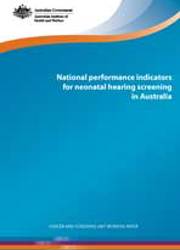Summary
Each year in Australia approximately 551 children are born with moderate to profound permanent childhood hearing impairment (PCHI) (MSAC 2007). Universal neonatal hearing screening aims to identify those children born with moderate to profound PCHI and provide them and their families with access to an appropriate intervention in order to minimise the impact of their hearing impairment. Universal neonatal hearing screening is undertaken in each Australian state and territory.
This working paper presents a set of performance indicators for monitoring neonatal hearing screening activity in Australia at a national level. National evaluation and monitoring provides a measure of how well neonatal hearing screening is achieving its aims and objectives and will enable strengthening of screening practices and administrative processes to further improve outcomes for Australian infants.
The indicators are based on the aims, standards and objectives for neonatal hearing screening outlined in the National Framework for Neonatal Hearing Screening (NHSWG 2013). They were developed in consultation with experts and endorsed by the Community Care and Population Health Principal Committee.
This working paper documents both the indicator development process and the technical specifications for the indicators. This working paper also identifies potential data sources, data elements and future data development and evaluation needs.
Key findings
Seven national performance indicators are described that cover four key areas along the screening pathway. The indicators, and how each relates to the four key aims of neonatal hearing screening, are listed below.
| Performance indicators | Aim |
|---|---|
| Indicator 1 Participation | To maximise the number of eligible infants screened for permanent childhood hearing impairment |
| 1.1 Participation in screening | |
| Indicator 2 Screening | To maximise the identification of infants with potential hearing impairment while minimising parental anxiety and cost |
| 2.1 Positivity rate of the screening test | |
| 2.2 Positive predictive value of the screening test | |
| Indicator 3 Audiological assessment and diagnosis | To accurately identify infants born with permanent childhood hearing impairment |
| 3.1 Audiological assessment | |
| 3.2 Detection of permanent childhood hearing impairment | |
| Indicator 4 Early intervention and management | To maximise engagement of infants identified as requiring a service with early intervention services |
| 4.1 Attend early intervention service | |
| 4.2 Infants fitted with an assistive hearing device |



